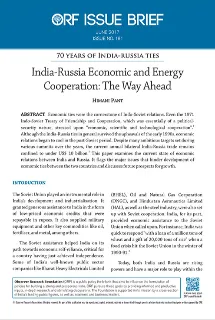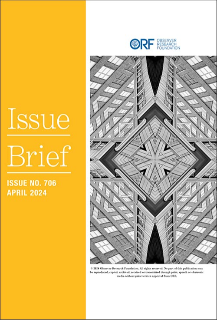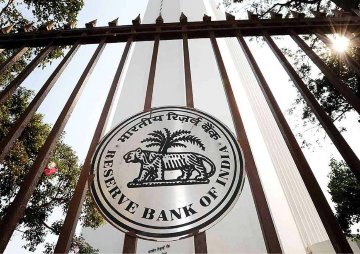Introduction
The Soviet Union played an instrumental role in India’s development and industrialisation. It granted generous assistance to India in the form of low-priced economic credits that were repayable in rupees. It also supplied military equipment and other key commodities like oil, fertiliser, and metal, among others.
The Soviet assistance helped India on its path towards economic self-reliance, critical for a country having just achieved independence. Some of India’s well-known public sector companies like Bharat Heavy Electricals Limited (BHEL), Oil and Natural Gas Corporation (ONGC), and Hindustan Aeronautics Limited (HAL), as well as the steel industry, were also set up with Soviet cooperation. India, for its part, provided economic assistance to the Soviet Union when called upon. For instance, India was quick to respond “with a loan of a million tons of wheat and a gift of 20,000 tons of rice” when a food crisis hit the Soviet Union in the winter of 1990-91.[3]
Today, both India and Russia are rising powers and have a major role to play within the international community. While both have diversified their foreign policy orientation to meet evolving global geopolitics, they continue to regard each other as special and privileged partners. The economic ties, however, remain the weak link in the relationship. While India and the Soviet Union shared robust economic relations, India-Russia trade today is dismally low.
Currently, Russia constitutes a mere one percent of India’s total trade, and India accounts for only 1.2 percent of Russia’s overall trade (2015-2016). According to estimates by the World Trade Integrated Solution, Soviet Union was the largest importer of Indian goods in 1989 at around US$ 2,881 million. That India’s exports to Russia in 2015 were worth only US$ 1,588 million highlights the dismal state of the bilateral trade relations.
India-Russia overall trade in 2015-16 amounted to US$ 7.83 billion.[4] This figure is well below India’s trade with its other major economic partners. By way of comparison, India’s bilateral trade with the US was about US$ 100 billion, with China about US$ 70.73 billion, and the EU, over 105.2 billion Euros for the same period.[5] Both countries have set a target to raise bilateral trade to US$ 30 billion by 2025 and mutual investments to US$ 15 billion.[6]
Table 1: Total imports from and exports to Russia (in US$ Million)
|
Year
|
Total imports
|
Total imports from Russia
|
Total exports
|
Total exports to Russia
|
| 2009-10 |
288,372 |
3,566 |
178,751 |
980,69 |
| 2010-11 |
369,769 |
3,600 |
249,816 |
1,689 |
| 2011-12 |
489,31 |
4,764 |
305,964 |
1,778 |
| 2012-13 |
490,736 |
4,231 |
300,400 |
2,296 |
| 2013-14 |
450,199 |
3,894 |
314,405 |
2,121 |
| 2014-15 |
448,033 |
4,249 |
310,338 |
2,097 |
| 2015-16 |
381,006 |
4,585 |
262,290 |
1,588 |
Source: Ministry of Commerce, Government of India[7]
Table 2: Comparison of total imports from and exports to Russia, the US, China and the EU for the year 2015-16 (in US$ Million)
|
2015-16
|
Imports |
Exports
|
| Russia |
4,585 |
1,588 |
| USA |
21,781 |
40,335 |
| EU |
43,898 |
44,461 |
| China |
61,706 |
9,010 |
Source: Ministry of Commerce, Government of India
Energy ties
As, respectively, energy-deficient and energy-surplus countries, India and Russia have a mutual interest in cooperation in this sector. According to a report by the International Energy Agency, India is likely to emerge as the world’s third largest energy consumer by 2025, behind only the US and China.[8]
Indo-Russian energy cooperation (particularly in hydrocarbons) continued despite both the countries’ tryst with a period of major transition in the 1990s. India continues to look towards Russia as its major energy supplier. This is manifested in its investment in Russia’s Sakhalin-1 hydrocarbon project (2001), one of the largest-ever foreign investments made by ONGC Videsh Ltd.
Recent developments include investments made by Indian companies like Indian Oil Corporation Limited (IOCL), Indian Oil Corporation Limited (OIL), and Bharat Petro Resources Limited (BPRL) in Russia’s Oil and Gas sector. This includes acquisitions of stakes in Russia’s Vankorneft, Taas-Yuryakh, among others.[9]
Nuclear Energy
In 1988, India and the Soviet Union signed a nuclear cooperation deal.[10] Today Russia continues to cooperate with India in the peaceful use of nuclear energy. India’s Department of Atomic Energy (DAE) and Russia’s Rosatom signed in December 2014 the Strategic Vision for strengthening cooperation in peaceful uses of atomic energy on behalf of their countries. This included a strategic vision document on the serial construction of nuclear power units in India by using Russian technology.[11] It outlines the plans for the construction of more than 12 nuclear power units in India, including the Kudankulam nuclear power plant in Tamil Nadu. Russia has already constructed two nuclear power plants at Kudankulam in 2013 and 2016, respectively, and the construction of the third and fourth power units is underway. Deals for Kudankulam 5 and 6 have also been signed.
Moreover, India and Bangladesh signed a civilian nuclear deal during Prime Minister Sheikh Hasina’s visit to India in April 2017. This deal is India’s second such pact in the neighbourhood after the one with Sri Lanka. The civil nuclear deal with Bangladesh will lead to trilateral cooperation with Russia, which is building a nuclear power plant in Rooppur in Bangladesh. This is the first time that India is cooperating with another country to develop a nuclear power project in a third country.[12]
The Russian Far East is an area of active bilateral energy cooperation. In December 2015, India’s Tata Power signed an agreement with the Russian Ministry of Far East Development for investment projects in the energy sector in the region.[13] There is a need to pursue further cooperation in this domain for mutual gain.
Bottlenecks in Indo-Russian Trade
The sub-optimal economic ties between India and Russia results from several bottlenecks. These include lack of physical connectivity, giving rise, in turn, to transport bottlenecks; lack of knowledge and enthusiasm on the part of the private sector; and the absence of trade facilitation mechanism and lack of banking ties.
- Transport bottlenecks: Geographical constraints translate to substantial financial costs and delays, while also constraining the number of products which could otherwise be more easily traded.
In this context, the partly-ready International North South Transport Corridor (INSTC) carries a lot of potential.
Figure 1: International North South Transport Corridor

Source: The Hindu
The multi-nation INSTC envisages moving freight from India, Iran, Azerbaijan and Russia via ship, rail and road. Once fully operational, INSTC would enhance India’s trade and investment linkages with Central Asia as well. It would reduce the cost of transportation of goods and transit time from India to Eurasia and the surrounding regions, as suggested by the dry runs that were undertaken in 2014. The first dry run was from Mumbai to Baku in Azerbaijan via Bandar Abbas in Iran. The second such effort was from Mumbai to Astrakhan in southern Russia via Bandar Abbas, Tehran and Bandar Anzali (all in Iran). Transport costs were estimated to be reduced by US$ 2,500 per 15 tonnes of cargo.[14]
- Lack of knowledge: Indians and Russians do not have sufficient knowledge and information about each other’s’ markets. There are not enough ‘business-to-business’ exchanges between the two countries. The lack of Indian and Russian media presence in each other’s country is an additional drawback. For instance, most of the news about Russia that reaches India is through Western media.
- Lack of interest from India’s private sector: After the economic reforms of the 1990s, India has undergone a successful transition from an inward-oriented economy to a more globally integrated one. In this process, the Indian private sector has played a crucial role. However, the dynamic Indian private sector, which is used to dealing with the West, is not as attracted to Russia. All major deals that are currently in place are partnerships between the public sectors of the two countries.
- Lack of proper trade facilitation infrastructure: Bureaucratic delays on both sides, among other factors, create obstacles for the smooth flow of business. Both countries are aware of this and to promote smoother and greater movement of business people, the two countries signed a protocol document on 24 December 2015 to simplify visa procedures for those doing business.[15] However, finance remains a key obstacle due to lack of banking ties. In this respect, some hope is attached to the emergence of new financial structures, such as the BRICS Development Bank and the Asian Infrastructure Investment Bank (AIIB).
Conclusion
India and Russia have a long-standing relationship and securing an economic and energy partnership is important from both the diplomatic and geopolitical perspectives. Russia has a vital role in ensuring India’s energy security in the coming decade. India imports oil, mostly from the volatile region of the Middle East. However, to sustain current high rates of growth, India needs to secure and diversify its energy sources. Russia is an obvious choice in this respect.
India-Russia economic relations carry a lot of potential, but they need to be scaled up. Both sides need to move beyond traditional areas of cooperation and explore areas like medical supplies, agricultural produce, and information technology, among others, to enhance bilateral ties.
This brief makes the following observations:
- In order to address these challenges and realise the trade and investment targets that have been mutually set, India and Russia should take the lead in finalising the Eurasian European Union Free Trade Agreement. INSTC also becomes relevant in this context, as it would help India’s economic relations not only with Russia, but also with the wider Eurasian region. This, especially, would add a boost to India’s Connect Central Asia Policy. India has maintained that there is a need for adopting an integrated approach whereby trade in goods is viewed in conjunction with trade in services and investments to tap the overall potential of the partnership.[16]
- Importing Liquefied Natural Gas (LNG) is the best alternative for India under existing conditions and therefore carries great potential in furthering India-Russia energy ties.
- Both countries need to pursue the operationalisation of the Green Corridor with greater vigour. The Green Corridor is the brainchild of Russia’s Federal Customs Service and suggests that the two countries should create a list of entrepreneurs or companies, whose goods, on a reciprocal basis will not have to pass customs inspection.[17] The mechanism ensures an electronic pre-declaration issued for the cargo, whereby a unique individual number is assigned in accordance with a “Green Corridor” registry.
- Swap deals are another way to enhance cooperation. For instance, Russia could export oil to Northern Iran and Iran could in turn deliver equal quantity of oil to India from its southern part. Another swap proposal includes Russia, China and Myanmar. Under this arrangement, Russia will supply gas to China and in return, China will give its share of gas from Myanmar to India. A smaller pipeline from Myanmar will need to be constructed in eastern India for importing that gas. [18]However, it must be noted that cooperation from third countries remains crucial even though they are regarded as the best way for Russia to help India meet its gas requirements.
- Infrastructure development also provides a huge opportunity and needs to be pursued with great vigour. As a welcome step, in the Goa summit last year, a bilateral investment fund by India’s National Infrastructure Fund with Russian Direct Investment Fund to facilitate high technology investments in both countries was created. Additionally, MOUs on developing smart cities, transport logistics, shipbuilding and railways in Andhra Pradesh, and cooperation in oil and gas among other areas were also signed. It is expected that Russia will also invest in the Delhi-Mumbai Industrial Corridor project. This project covers an area of about 400,000 sq.km and six states with a population of 178 million. This project incorporates nine mega industrial zones.
- Potential also lies in India’s diamond market. India is known for processing diamonds while Russia is among its leading suppliers. More than 80 percent of Russian raw diamonds make their way to India indirectly via European intermediaries. Both sides need to develop a mechanism to ensure a more direct supply at reduced costs and with a faster dispatch rate.
- The next area for enhanced cooperation is pharmaceuticals. The Russian pharmaceutical market is estimated to be “about $10 billion, growing at 7.4 percent in local currency terms”.[19] For a long time now, Indian drug companies have tried to foray into the Russian market with little success. As a welcome step, India’s leading drug company, Sun Pharmaceuticals signed an agreement with Russia’s Biosintez for acquiring its majority stake for about US$ 60 million last year. While the stake is modest at best, it opens avenues for enhanced cooperation in the future. However, the transaction is subject to approval by the Russian Federal Anti-Monopoly Service along with other contract requirements.
In addition, there is a rising demand for alternative medicines in Russia. While there are a few Ayurveda clinics in Russia, a boost to Ayurveda is required.
- A greater push needs to be given to transport via air of perishable goods like dairy items and fruits. For instance, there is high demand for mangoes in the Russian market, which are currently being imported mainly from Latin American countries. India needs to tap into the full potential of the fruits market that Russia offers.
- Finally, there is great potential for cooperation in the information technology sector. The Indian IT sector has emerged as a great success in the West and can contribute significantly in Russia too. This holds even greater significance in the current environment where Indian IT firms are facing a setback in the US.
Endnotes
[1]Ministry of External Affairs, Government of India, “Treaty of Peace, Friendship and Co-operation,” Ministry of External Affairs, Government of India, August 9, 1971, http://mea.gov.in/bilateral-documents.htm?dtl/5139/Treaty+of+.
[2]Embassy of India in Moscow, “Bilateral Relations: India-Russia Relations,” Embassy of India in Moscow http://indianembassy.ru/index.php/bilateral-relations/bilateral-relations-india-russia.
[3] “India – from Soviet ally to Russian trading partner,” The BRICS Post, October 20, 2013, http://thebricspost.com/india-from-soviet-ally-to-russian-trading-partner/#.WQbeH0WGMdU.
[4] Ibid.
[5] World Bank, “Country Snapshot: India,” World Bank, http://wits.worldbank.org/CountrySnapshot/en/IND.
[6] Ram Upendra Das and Anup Kumar Jha, “How to take Russia-India economic ties to the next level,” Russia Direct, October 14, 2016 http://www.russia-direct.org/opinion/how-take-russia-india-economic-ties-next-level.
[7]Ministry of Commerce, Government of India, “Export Import Databank,” Ministry of Commerce, Government of India http://commerce.gov.in/EIDB.aspx.
[8]International Energy Agency, “India Energy Outlook,” International Energy Agency https://www.gita.org.in/Attachments/Reports/IndiaEnergyOutlook_WEO2015.pdf.
[9] Nivedita Das Kundu, “India-Russia Relationship: Past, Present and Future,” Valdai, June 14, 2016, http://valdaiclub.com/a/highlights/india-russia-relationship-past-present-future/.
[10]Muchkund Dubey, “Indo – (Soviet) Russian Relations,” Mainstream, L (40), September 22, 2012, http://mainstreamweekly.net/article3704.html.
[11]Ministry of External Affairs, Government of India, “Strategic Vision for Strengthening Cooperation in Peaceful Uses of Atomic Energy between the Republic of India and the Russian Federation,” Ministry of External Affairs, Government of India, December 11, 2014, http://pib.nic.in/newsite/PrintRelease.aspx?relid=113165.
[12] Dipanjan Roy Chaudhury, “India-Bangladesh Russia Civil Nuclear Cooperation on the Cards,” The Economic Times, March 23, 2017, http://economictimes.indiatimes.com/news/politics-and-nation/india-bangladesh-russia-civil-nuclear-cooperation-on-the-cards/articleshow/57782501.cms.
[13]Chittaranjan Tembekar, “Tata Power signs a pact with Russia for investment in energy sector,” December 29, 2015, http://timesofindia.indiatimes.com/business/india-business/Tata-Power-signs-a-pact-with-Russia-for-investment-in-energy-sector/articleshow/50372636.cms.
[14] “Iran, Russia, Azerbaijan vow to create NSTC,” Press TV, August 8, 2016, http://www.presstv.com/Detail/2016/08/08/479121/Iran-Russia-Azerbaijan-vow-to-create-NSTC
[15]Ministry of External Affairs, Government of India, “Joint Statement between the Russian Federation and the Republic of India: Shared Trust, New Horizons,” Ministry of External Affairs, Government of India, December 24, 2015, http://mea.gov.in/bilateral-documents.htm?dtl/26243/Joint_Statement_between_the_Russian_Federation_and_the_Republic_of_India_Shared_Trust_New_Horizons_December_24_2015.
[16]Ram Upendra Das and Anup Kumar Jha, see n.6
[17]Dipanjan Roy Chaudhury, “India Russia to put in place a ‘Green Corridor’, to enhance bilateral trade,” The Economic Times, September 16, 2016, http://economictimes.indiatimes.com/news/economy/foreign-trade/india-russia-to-put-in-place-a-green-corridor-to-enhance-bilateral-trade/articleshow/54355281.cms.
[18]“India discussing natural gas swap with Russia, involving China”, The Financial Express, December 8, 2016, http://www.financialexpress.com/india-news/india-discussing-natural-gas-swap-with-russia-involving-china/467819/.
[19] “India’s Biggest Pharmaceutical Company Enters Russian, CIS Markets,” Sputnik International, November 23, 2016, https://sputniknews.com/asia/201611231047755695-india-drug-maker-russia/.
The views expressed above belong to the author(s). ORF research and analyses now available on Telegram! Click here to access our curated content — blogs, longforms and interviews.

 PDF Download
PDF Download




 PREV
PREV

